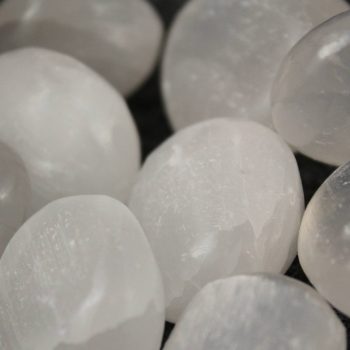Satin Spar
A white or orange mineral which can sometimes appear clear – it is prettiest when combined with a light source.
Satin Spar is almost always sold as Selenite, but this is not correct mineralogically speaking.
Showing the single result
Appearance, Uses and History
No, this material is not Selenite. Geologically, it is Gypsum, var Satin Spar.
This is a really important distinction that needs to be made, unfortunately. This is one of the most commonly missold minerals on the market.
So, what’s the difference between Satin Spar and Selenite?
So, first of all, I need to introduce you to the mineral Gypsum. Gypsum is a sulfate mineral composed of Calcium Sulfate Dihydrate. Gypsum has several forms:
- Alabaster is a fine-grained form of Gypsum often used for carving.
- Desert Rose is a crystalline form of Gypsum, specifically the name given to rose-like formations of Gypsum or Baryte with numerous inclusions of sand grains.
- Satin Spar is a crystalline form of Gypsum, which occurs in long, silky crystals with a fibrous nature. It is typically white or orange.
- Selenite is a crystalline form of Gypsum, and is transparent and colourless.
- Selenite is also, unfortunately, a name given to the crystalline structures of Gypsum – as well as being a member of that group.
So, when people refer to Selenite, they may be referring to a specific mineral or one of the four crystalline forms of Gypsum.
For this reason, mineralogists tend to refer to these minerals in the form Gypsum var Selenite or Gypsum var Desert Rose. To refer to them as Selenite only confuses matters – a simple google search will prove that!
As of 19/06/2020, 11/12 of the top Google images for ‘Selenite’ are actually ‘Satin Spar’. Etsy UK has the same problem – 11/12, and eBay had 11/12 Satin Spar pieces – and one that is a dyed Quartz geode..
Gypsum is widely used in industry, used as a fertiliser, and in many forms of plaster. Satin Spar is used as a decorative stone too, but it is a very soft material and has severe limitations.
Jewellery made from Satin Spar simply isn’t feasible, as it would fracture easily and scratch even more easily. Tumblestones made from Satin Spar tend to be hand polished, as the tumbling process would quite easily destroy the material… however, carvings are relatively common.
Satin Spar is particularly popular with new-age crystal healers.
Locales
Satin Spar is found in a few countries worldwide, including Australia, Canada, France, Latvia, Mexico, Poland, Spain, the UK, and the USA.
Mineralogy
Hazards and Warnings
Satin Spar is water soluble and should be kept away from humid areas and direct contact with any liquids. It is non toxic, but if broken, cut, or polished, care should be taken to avoid inhalation of the small fibers.
When researching the hazards of Selenite of any kind, you may see references to Sodium Selenite, which is an unrelated chemical compound.
Almost all rocks, minerals (and, frankly, almost all other substances on earth) can produce toxic dust when cutting, which can cause serious respiratory conditions including silicosis.
When cutting or polishing rocks, minerals, shells, etc, all work should be done wet to minimise the dust, and a suitable respirator or extraction system should be used.
Translations
Given the confusion in the English speaking world about Selenite and Satin Spar, this may not translate well at all.
Arabic:
Hindi:
- साटन स्पार
Portuguese:
Bengali:
- সাটিন স্পার
Indonesian:
Punjabi:
- ਸਾਟਿਨ ਸਪਾਰ
English:
- satin spar
- satin spar gypsum
Italian:
Russian:
- атласный лонжерон
French:
Japanese:
- サテンスパー
Spanish:
German:
Korean:
Thai:
Gujurati:
- સાટિન સ્પાર
Mandarin and Traditional Chinese:
Urdu:

